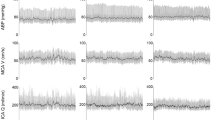Summary
¶Objectives. Patients with carotid artery stenotic disease and poor cerebral haemodynamic reserve are in increased risk of stroke. Haemodynamic reserve can be estimated by measuring cerebrovascular reactivity induced by breathing CO2 and pressure-autoregulation by analyzing spontaneous slow fluctuation in arterial pressure and MCA blood flow velocity. We evaluated the relationship between clinical status, CO2 reactivity, pressure-autoregulation and other haemodynamic variables derived from Transcranial Doppler ultrasonography in patients with carotid artery disease.
Methods. 38 patients were investigated. Arterial pressure and blood flow velocity were monitored during CO2 reactivity tests. Arterial pressure-corrected and non-corrected indices of CO2 reactivity were calculated to compare an influence of rise in arterial pressure during the test. The pressure-autoregulation index was calculated as correlation coefficient between slow waves in blood flow velocity and arterial pressure.
Results. The increase in CO2 produced a consistent rise in arterial pressure and blood flow velocity and weakened the pressure autoregulation. The value of pressure-corrected CO2 reactivity was lower (p<0.0001) than the non-corrected one, indicating that the rise in arterial pressure during the test tends to over-estimate CO2 reactivity. The pressure-corrected reactivity was correlated with pressure autoregulation (r=−0.46; p<0.005). Both CO2 reactivity and pressure-autoregulation index correlated with a degree of carotid artery stenosis. Side-to-side difference of TCD pulsatility index demonstrated a close relationship with the asymmetry of stenosis (r=−0.61; p<0.0002) and symptoms (r=−0.49; p<0.003).
Conclusions. When calculating CO2 reactivity in patients with carotid artery disease, changes in arterial pressure should be considered. Both CO2 reactivity and pressure-autoregulation describe the magnitude of haemodynamic deficit caused by stenosis, pulsatility index expresses the asymmetry of stenosis.
Similar content being viewed by others
Author information
Authors and Affiliations
Additional information
Published online July 31, 2003
Rights and permissions
About this article
Cite this article
Gooskens, I., Schmidt, E., Czosnyka, M. et al. Pressure-autoregulation, CO2 reactivity and asymmetry of haemodynamic parameters in patients with carotid artery stenotic disease. A clinical appraisal. Acta Neurochir 145, 527–532 (2003). https://doi.org/10.1007/s00701-003-0045-y
Issue Date:
DOI: https://doi.org/10.1007/s00701-003-0045-y




